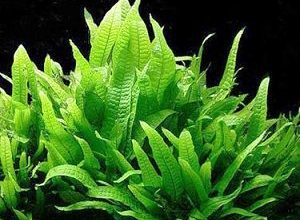Java Moss


- Scientific name: Vesiucularia dubyana
- Common Name: Java Moss
- Temperature: Between 18ºC to 26ºC
- pH: Between 6.5 and 8
- Difficulty level: Low
- Growth, height: 5 cms
Description
The famous Java Moss, Vesicularia dubyana belongs to the Vesicularia family.
It is one of the most popular plants in aquariums because it is very easy to care for, and suitable for any beginner in the aquarium world.
It is a cover plant, the aquarium moss that develops on any surface: the rocks , logs and gravel at the bottom of the aquarium, creating a much more natural appearance to the whole.
It does not need to root on the substrate, it «hooks» to any surface by means of a kind of roots called rhizoids.
If we let it grow, it will end up covering the entire bottom of the aquarium, beingthe perfect mat to protect the smallest fish species.
It is also very appreciated to place in aquariums intended for breeding , since it creates a kind of natural refuge for the eggs of the spawn, where the adults cannot reach to eat them.
Shape
That dense, silky and fluffy appearance that Java Moss has, is the result of the way it grows.
It has a multitude of filaments, also called elongated filiform stems, from which small pointed leaves grow, 1.5 mm wide and about 5 mm long.
The stems end up intertwining with each other, creating that dense bush so appreciated and original.
Java Moss is usually medium green in color, but can have various shades ranging from dark green to almost transparent light green.
Inside the aquarium its growth is slow at first, since it needs a period of acclimatization, but once it is overcome, its development accelerates and completely covers any aquarium.
Distribution and habitat
As its name suggests, Java Moss is native to Southeast Asia and it is the island of Java that gives it its name.
In its natural state, it can be found in slow water currents, in rivers with areas of intense shade, in the depths of lagoons, lakes and small streams.
Aquarium conditions
They are suitable for any type of freshwater aquarium , slightly acidic .
The ideal aquarium conditions for Java Moss to grow well are:
- Temperature between 20ºC and 28ºC
- Hardness between 10 gH and 12 gH
- pH between 6.5 and 8
Java Moss Care
They require fresh, slightly acidic waters with temperatures above 20ºC, although they can withstand temporary drops in temperature.
How to sow Java Moss
It is an extremely easy plant to care for. We don’t need their roots to come into contact with the substrate , they can survive on any surface, even glass.
If we want it to develop on the bottom of the aquarium, we will lightly bury its roots, and in a few days it will be growing.
On the contrary, if we want it to cover some rocks or a log, we will use a little fishing line to hold it until it takes root. Once rooted, we remove the thread.
illumination
It prefers dim lighting, although it will be able to adapt to all types of lighting. With excessive lighting, algae will proliferate and become entangled with the plant.
Algae are very difficult to remove, but it must be done so that they do not end up suffocating it. Do not use any anti-algae product, which would also harm Java Moss.
If it is very attacked, remove the areas with more algae, it will grow back without problems.
Reproduction: Grow Java Moss
In nature, Java Moss reproduces by spores, but in an aquarium it is very complicated.
The best way to reproduce it is by division of the plant.
We take a piece of the plant, which is removed very easily, and proceed to plant in another place.
As it is a plant that does not «take root» on the substrate and that the food it receives is through its leaves, it is recommended that the aquarium where we are going to place it is already cycled and in operation for some time (mature).
Pruning
At first we will not need to prune the Java Moss, as I have told you it has a slow growth at the beginning.
But as it grows and «invades» the aquarium, it becomes necessary to keep it within growth limits.
Pruning shears can be used, or by hand, remove the excess parts.
Remember that when you put your hands in the aquarium they have to be clean and “free” of chemical products, such as soaps.
How to repair Brown Java Moss
One of the common problems with Java Moss is that it turns brown. This is synonymous with the fact that that area of the aquarium moss has died.
The Java Moss has its own requirements , like all aquarium plants and the one that acquires a brown tone, as dirty, is that the parameters and conditions are not suitable.
The first thing we have to do is remove the damaged parts. Sometimes, doing absolutely nothing, the parts that are still green start to grow.
But … if we do not solve the problem that causes the Java Moss to spoil, it will soon turn brown again.
One of the reasons aquarium moss – both Javanese and Flame Moss – turn brown is over-lighting.
Check your aquarium lighting. For the moss to be perfect, it should not exceed 6,500K per liter.
Another measure that works extraordinarily well is to increase the CO2, or to start using it.
Buy Java Moss
You don’t know where to buy Java Moss? Don’t worry, I have the solution, the Java moss at the best price:








